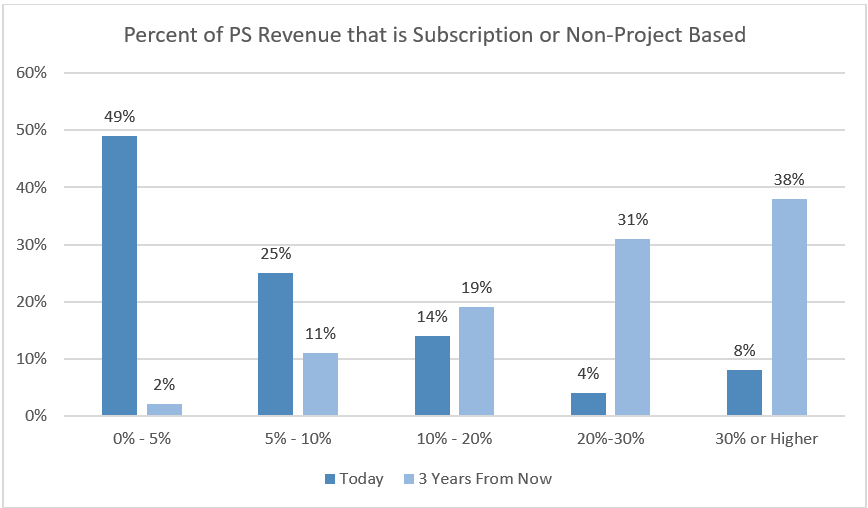
TSIA recently conducted an Economic Sentiment Survey with our members in the B2B technology space to consult them regarding their views on the economy in 2023.
The good news is that 73% of respondents had positive expectations around company revenues, stating that they anticipate growth in 2023. The not so good news is that 49% of organizations expect their headcount to remain flat or decline, while 57% of companies expect budgets to remain flat or to become reduced. For professional services, this means your revenue number will go up, but you’ll be stretching your resources and adjusting business models to scale operations while maintaining profitability.
In this blog, I will discuss three strategies that professional services executives must consider to ensure profitable growth in 2023. The three strategies for success include the following:
- Proactively manage project margins
- Maximize utilization rates and rate realization with resource management
- Actively identify new revenue streams
Proactively Manage Project Margins
Last year, I interviewed a dozen TSIA members about how they were using their current professional services automation (PSA) system. What I found is that companies tend to invest in PSA for a particular business challenge, often resource management, revenue forecasting, or billing, and had never extended their use of the platform beyond that initial use case. In fact, very few of those companies surveyed were using the PSA platform to manage their projects.
With project margins under a microscope, companies must leverage the full scope of a PSA platform. That includes the use of project management modules instead of defaulting to some freeware or low-end project management tool. Doing so will dramatically improve your visibility into project profitability, so adjustments can be made to avoid margin erosion.
- Timely project updates. A critical part of this is ensuring consultants are logging all expenses, work performed, and project updates into the system in as real time as possible. This provides project managers and executives with an accurate view of project progress and costs at all time.
- Management dashboards. With all project information being collected in a timely manner, dashboards will provide managers with visibility into the status of projects and track the margin of each from a single view. This level of visibility makes it easy to spot small issues before they become big issues, without wasting hours of time reading through project updates.
Project managers have many considerations to juggle when staffing project teams. To maximize both metrics, companies must wean themselves off manual scheduling and rely on the resource management module of their PSA system.
John Ragzdale, VP Technology Ecosystems at TSIA
Resource Management: Maximize Utilization Rates and Rate Realization
Obviously, professional services is a people business, and the economics of consultants can make or break the margin for a project. In particular, there are two critical metrics that consultants must follow:
- Utilization rate. This metric measures what percentage of time consultants are conducting revenue-generating activity, as opposed to internal meetings, sales support, or sitting on the bench. According to TSIA’s Professional Services Benchmark Survey, the industry average for billable utilization rates are 58%, with pacesetters averaging around 72%.
- Rate realization. This metric is the percentage of target billing rates for consultants that are collected after discounts. The industry average for rate realization is 79%, which means that on average, 21% of the time, consultants are being billed at less than their actual billable rate.
Project managers have many considerations to juggle when staffing project teams. To maximize both metrics, companies must wean themselves off manual scheduling and rely on the resource management module of their PSA system.
As professional services introduce additional offer types, new skills sets will be required.
In order to maximize project success, resource assignments should not only look at utilization rates and rate realization, but also incorporate a skills matrix.
By using a skills matrix, the system knows which consultants have the required technical skills to ensure scheduling decisions are based on business acumen for specific industries or desired customer outcomes. Some of the top PSA systems now include capabilities to track skills, training, and certification, as well as domain expertise.
Leveraging automated resource management, your PSA system should be able to look at the requirements for a project, and identify the best team, based not only on skills levels, but also each consultant’s billable rate, and their current utilization rate. Using technology to balance all of these factors, you will decrease bench time for consultants, as well as achieve a higher rate of rate realization by intelligently balancing project costs, desired margin, and consultant billing rates.
New Revenue Streams
So far we have looked at how to maximize profitability for professional services. But boosting revenue is critical too, and for this, PS needs to identify new revenue streams. Three considerations that will create new revenue streams outside of traditional implementation, integration, and customization projects, are:
- Value based offers
- Subscription renewable services
Over the last few years, we have seen the charter of professional services evolving
When asked to prioritize the charters of professional services in a recent TSIA survey, “Adoption/Customer Value” achieved the top ranking, over previous top charters of “Margin” and “Revenue.”
41% of XaaS companies have documented methodology for developing professional services offers. The intent being the needto increase the adoption of products by existing customers, yet currently value-based offers only account for 6% of total revenue. For professional services to fulfill their charter of accelerating adoption and customer value, creating a catalog of value-based offers is critical.
Customer success and professional services organizations must partner together
According to a TSIA R3 Poll on Monetizing Customer Success, 42% of customer success organizations have introduced monetized offers. 71% of companies monetizing customer success offer process consulting to help companies refine core process and take greater advantage of technology features and automation. The remaining 68% of companies offer services for adoption planning, and adoption optimization, these are all offers that would best be delivered by professional services. Professional services needs to tightly partner with customer success to understand what offers to create, but also to coach success managers on identifying opportunities to extend these offers to customers. This should be a natural part of a CSM’s role, not left to a sales.
Professional services organizations are recognizing the revenue value of subscription models
In the webinar, Moving to a Subscription Model in Professional Services, presented last year by Bo Di Muccio, Distinguished VP, and Dave Young, Sr. Director, from TSIA’s Professional Services research team. 61% of the audience were either subscription “curious,” or had already taken some initial steps toward introducing subscription offers for professional services. Though currently we aren’t seeing most companies realizing significant revenue from renewable offers, with the current focus on shifting to this model, when asked to project subscription PS revenue in three years, most companies foresee this becoming a critical source for PS revenue in the future. This is the logical approach for customers to consume value-added services, and as a part of creating a new catalog of these services, you should also build a plan to sell them as subscription, renewable services.
Chart: Current and Projected Revenue from Subscription PS Offers

Source: TSIA Webinar Poll, July 2021
Final Thoughts
Most B2B tech firms already see professional services as a major driver of revenue, though previously this revenue came solely from implementation, integration, and customization projects before go-live. With a tough economic climate, companies are looking for additional sources of revenue. As a result, we recognize professional services as the center of revenue growth, as discussed in this blog.
But it isn’t about additional revenue, it is also important to be sure PS revenue is as profitable as possible. For this, companies need to leverage the full capabilities of their PSA platform, particularly proactive project management, and resource and skills management. With all of this in place, PS teams should have a successful 2023.
Next Steps
If you would like more information on any of these topics, I invite you to watch a recorded webinar “Make 2023 The Year of Profitability: Driving Growth and Profits within Professional Services,” hosted by myself, and Planview’s Sr. Director of Product Management, Dave Blumhorst.




